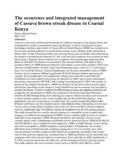| dc.description.abstract | Cassava is vital source of food and livelihoods for millions of people in sub-saharan Africa and its production is mainly constrained by pests and diseases. A survey to determine farmers' knowledge, incidence and severity of Cassava Brown Streak Disease (CBSD) was carried out in four cassava-producing districts in coastal Kenya namely Lamu, Malindi, Kilifi and Kwale in March 2005. A total of forty-four fields were surveyed along main and feeder roads transversing the districts at predetermined intervals of 5 km. Leaf and stem symptoms were assessed on thirty plants along a diagonal transect whereas root symptoms were assessed upon uprooting three plants in each field.
The disease was prevalent in the surveyed districts with highest mean incidence (99%) of CBSD being recorded in K wale district. Lowest mean incidence (96%) was observed in Kilifi district. Severity scores were determined using a scale of 1 to 5 and ranged from 3 to 4 in all the districts. Variety Kibandameno was the most susceptible variety to CBSV. Severity of root symptoms differed significantly (P:S0.05) between districts and among the varieties. Five asymptomatic and symptomatic cuttings were collected in each field and established in an insect-proof screen house for detection of CBSV using reverse transcriptase polymerase chain reaction (RT-PCR).
Fifty cuttings were diagnosed for CBSV and seventy six percent of the samples were positive. CBSD was found to be prevalent in the surveyed region and farmers' knowledge on the disease is scanty therefore no concise measure was instituted to manage the disease. A study to evaluate the effectiveness of using clean planting materials and rouging for the management of CBSD was conducted at the Kenya Agricultural Research Institute (KARl) Mtwapa during short and long rain seasons. Disease incidence and severity for
i.e above ground symptoms were scored monthly upto the 9th month after planting. ~tetly populations were also monitored on a monthly basis. The results revealed that Bemisia afer (Priesner and Rosny) was the abundant species while Bemisia tabaci (Gennadius) was the least. Cassava brown streak disease incidence and severity for above and below ground symptoms were not significantly (pg>.05) different among the treatments over the two growing seasons. This study showed that use visually selected cuttings of a susceptible variety coupled with rouging is not effective in management of CBSD.
Cassava varieties differ in terms of symptom expresSlon when exposed to CBSD. Diseased and disease free materials of local cassava varieties namely Guzo. Kibandameno and Pamba and two advanced lines to CBSD (97ILMLli19 and 97ILMLl051) were evaluated for their response to CBSD, at KARl Mtwapa. Local varieties were more susceptible to CBSD compared to advanced lines. Kibandameno was severely affected in terms of foliar and stem symptoms ranging from 3 to 4 on severity scale.
Guzo showed tolerance to foliar symptoms while Pamba was moderately susceptible with severity scale of three and two respectively. Advanced lines to CBSD and Pamba had no observable root symptoms while Guzo showed mild root constrictions. Root yield did not differ significantly at P-S 0.05 among the treatments and witliin the varieties through out the two growing seasons. This study indicates that use of resistant variety such as LMLl051 and LMLli19, careful selection of cuttings from tolerant variety such Guzo and Pamba and rouging could make a significant contribution towards CBSD management in farmers fields. | en_US |

